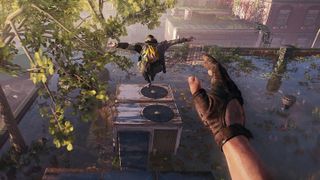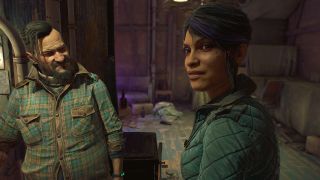Dying Light's parkour has me running back to Mirror's Edge
These zombie-fleeing sneakers don't quite fit right.

I've been picking fights, readers. Not with zombies, or renegades, or the binary factions of Dying Light 2's post-apocalyptic urban sprawl. Instead, I've been picking fights with the rest of the PC Gamer team, who feel that no matter how you ultimately land on the game, you've gotta agree that the parkour is fun as hell.
It's something even the most negative reviews of Dying Light 2 seem to agree on, too—that for as naff as the story is or as bland as the combat might be, at least the free-running is good. But after a week of trying to make myself fit into Dying Light's running shoes, I can't help but strongly feel that they just don't quite fit.
Everybody jump around
Dying Light 2, like its predecessor, wants to be an open world Mirror's Edge with zombies; a game where you're fleeing the undead by vaulting and wallrunning across rooftops as much as you're smashing their faces in with a length of pipe. It's a fantasy that sounds phenomenal, and too few games are as interested in making running as fun as fighting. But from the minute I stepped into the grubby trainers of leading lad Aiden, I realised I was about to have a bad time.
I can sum up all of my issues with Dying Light 2's movement system with one mechanic: The Jump. Aiden's jump is a bizarre thing—a slugging, floaty hop that feels less like he's pushing himself free of earth's pull with his legs, and more like some invisible forklift is slowly raising and lowering him with every hold of the space bar.

Dying Light 2 co-op: How to play with friends
Dying Light 2 skills: Which to choose
Dying Light 2 tips: Outrun the zombie apocalypse
Dying Light 2 Inhibitors: Boost your stamina and health
Dying Light 2 safe codes: Don't miss any loot
Dying Light 2 repair weapons: How to do it
You can sorta understand why it's like this. Dying Light 2's jump is astonishingly forgiving, a jump designed by people who still think first-person platforming is an unsolved problem. A moon-jump to ensure you have a full minute to decide where your feet are going to land. It is designed to put as few obstacles between you and where you want to go, but in a way that feels so disconnected from Aiden as a physical presence that I no longer feel like I'm controlling a character—rather a disembodied camera with legs.
There's a looseness that carries over into so much of Dying Light's parkour. A seamlessness that means I'll be holding W to climb a pipe and suddenly be hanging from a windowsill. Running into ropes to swing over fences, vaulting crates and jumping rooftops has the feeling of trying to grab a shoreline while being swept slowly downstream.
By the time I got to Villedor proper, another problem reared its head. Dying Light 2 uses a stamina system to ensure you can't clamber up skyscrapers from the get-go. But figuring out the best ways to climb up the side of a building should be a challenge in and of itself. In the opening missions, my NPC bud is constantly having to kick down ladders for me after my noodle arms keep failing.
The biggest gaming news, reviews and hardware deals
Keep up to date with the most important stories and the best deals, as picked by the PC Gamer team.
Stamina is both a crutch for the fact that an open-world sandbox can't create bespoke parkour challenges, and a gating mechanism. I'm sure I'll be able to climb towers with reckless abandon in 5, 10 or 20 hours, just as I'll be allowed to do fun stuff like sliding or wall-running or swinging off grappling hooks. Dying Light 2 is a game that wants parkour to be as frictionless as possible, while putting up constant roadblocks to bring your urban escapades to a halt.
Moving on up
Look, I care a lot about movement in games. Maybe too much, even. Games are incredible in the way they let you exist within fully-realised virtual spaces, and how a game chooses to let you traverse that space can say a lot about its character.
In Mirror's Edge, you feel like you're inhabiting Faith's body, her arms pressing against nearby walls, her legs always beneath you as you perform ever more daring tricks. Gaining and maintaining speed takes work, but when you're at full pelt, bounding around guards and soaring between cranes, you not only feel like you've fully mastered a real skillset—you feel a deep understanding of the physical competence of our rooftop deliverywoman. The friction is the point.
The same goes for Titanfall 2, which uses its rocket-powered wallrunning to sell the fantasy of being a far-future parkour soldier, nipping around the battlefield at nonsensical speeds. The very first game I ever played, Jet Set Radio Future, is a riot of effortless movement, its high-flung rollerskating a key part to its message of vibrant protest against a system that wants to keep people drab and grounded.
I don't know what Dying Light is trying to say with its movement. In our own chats, Morgan has suggested that it's meant to make Aiden feel like the part-zombie superhuman, that the world is "a playground for batshit parkour with its own clear limits that you tear away over time with upgrades". But those limits feel too harsh too soon, and Aiden doesn't feel like someone who's been clambering around buildings all his life—he feels like a hapless chump drifting listlessly across rooftops.
pic.twitter.com/qOsL75eVeKFebruary 2, 2022
Running across Villedor is floaty and fussy, and it needlessly gates you out of all the fun stuff until you're too invested to back out.
Unlike Mirror's Edge, Dying Light 2 isn't a game about parkour. Not really. It is a game that happens to include parkour on its laundry list of blockbuster features the game has bloated itself with, sandwiched somewhere in between deteriorating weapons and craftable lockpicks. And maybe that's my problem—I haven't played one of these 500 hour, vaguely Ubisoft-ish action RPG forevergames in, well, forever.
As Fraser noted, Dying Light 2 kneecaps itself by pretending to be an RPG—though as you might have noticed, I disagree that the parkour feels good from the get-go. A good parkour game would give me the entire toolkit from the jump and find more and more ways to test myself with the same verbs. Dying Light 2 gives me a floaty jump and the upper body strength of a small child.
Techland has presented a world where movement becomes more fun not because I learned how to get better, but because I made the numbers go up until I could jump higher. That maybe I'll get to pull off some sick runs in 20 hours, when a web of skill points and progression metrics has deemed me worthy of getting to enjoy one of the game's key mechanics.
When faced with a choice between that and a game that cares about deep, complex movement, I always know which way I'll turn and run.

20 years ago, Nat played Jet Set Radio Future for the first time, and she's not stopped thinking about games since. Joining PC Gamer in 2020, she comes from three years of freelance reporting at Rock Paper Shotgun, Waypoint, VG247 and more. Embedded in the European indie scene and a part-time game developer herself, Nat is always looking for a new curiosity to scream about—whether it's the next best indie darling, or simply someone modding a Scotmid into Black Mesa. She also unofficially appears in Apex Legends under the pseudonym Horizon.

OG Fallout lead Tim Cain explains just how much thought went into the timeline, and why canned beans were key: 'Post-apocalypse, but not so far post- that everything's collapsed and everyone's dead'

Path of Exile 2's character customisation can't compete with Diablo 4's hellishly good drip, but the good news is you'll barely notice
Most Popular


